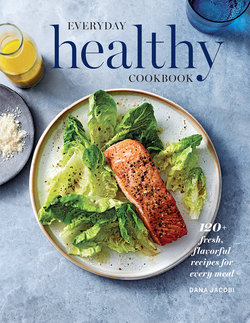Читать книгу Everyday Healthy Cookbook - Dana Jacobi - Страница 14
На сайте Литреса книга снята с продажи.
ОглавлениеGood Food for Good Health13
protein power
Everycell in our bodies needs protein. Its amino acids helpbuildand maintain muscle, strengthen bones, repair damaged DNA, andmore. Animal protein, containingall nine essential amino acids, is complete. Vegans can benefitfromfoodswith complementary aminoacidsthat together provide the essential nine. Vegetarians can get complete protein by including some cheese, eggs, or dairy in meals.
Some animal foods eaten for protein—includingsalmonand other oily fish, pastured chicken and chicken eggs, andgrass-fedbeef—also provide fatty acidssuch asomega-3s.Importantinflammation fighters, omega-3s are necessaryin our diet because our bodies cannot makethem. Certain plant seeds, such as chia and flax, supply one type of omega-3s. Nuts are also a good source.
FISH & SEAFOOD
The omega-3 fats in fish and seafood help keep our memories sharp and our moods bright. Their anti-inflammatory benefits also help protect us from stroke and improve “good” HDL blood cholesterol. Oily fish, including salmon, sardines, albacore tuna, and mackerel are richest in omega-3s. Cod, trout, hal-ibut, shrimp, and mussels are other good sources. All fish are a super source of vita-min D, which is needed for strong bonesand a robust immune system; riboflavin (vitamin B-2), which helps cells function; and zinc, a trace mineral essential for a healthy immune system. Eating fish twice a week is often recommended for optimum health.
MEAT & POULTRY
To bring meat and poultry into yourdiet in the healthiest way, look for beef, pork, lamb, chicken, and tur-key that is raised organically and humanely. “Organic” means animals are given feed or grazed on land entirely without chemical pesticides or fertilizer, raised without hormones or antibiotics, and given outdoor access. Meat from lifestock that are grass fed or pastured and poultry that are free-range contains higher amounts of healthy omega-3 fatty acids, so opt for these when possible.
DAIRY
Dairy foods are great sources ofprotein, calcium, and an abundance of other nutrients, vitamins, and minerals. Their many forms and the complex flavors in cheese and other fermented dairy foods easily add variety to meals. Dairy foods with live cultures, like yogurt and kefir, also contribute greatly to our digestive and immune health.
EGGS
Eggs provide top-quality protein, plus vitamins D and E, choline for brain and eye health, carotenes (a key antioxidant), and potassium, which supports good blood pressure, cardiovascular health, bone strength, and muscle strength. They also contain cholesterol, which is essen-tial togood health but detrimental in overabundance. Unless your body is cholesterol sensitive or insulin resistant, daily eggs are now considered to be a great addition to a healthy diet. Look for organic eggs, preferably from pasture-raised chickens for the highest levels of omega-3s and vitamins A and D.
BEANS & LENTILS
A main source of protein in manycultures, fiber-rich beans and len-tils promote a healthy gut and sta-ble blood sugar levels. Each kind of
legume has its own personality and combination of antioxidants. Black beans are rich in an antioxidant called kaempferol, thought to help prevent cancer. Lentils are loaded with folate, a B vitamin that helps reduce the risk of birth defects and breaks down homocystine, associated at high levels with depression. Look for locally grown beans, dried or fresh in season. Canned beans are nutritionally as good as dried and a perfect time-saver.
MUSHROOMS
In a class of their own, these ediblefungi offer good-quality protein useful in meatless meals. Mushrooms are rich in selenium, a mineral that reduces inflammation and boosts the immune system. Shiitakes are particularly ben-eficial. All mushrooms, cultivated and wild, add savory umami flavor and a “meaty” feel to dishes.
SOY FOODS
Soybeans are the vegetarian proteinchampion, providing complete, cho-lesterol-free protein in a wide variety of forms. Isoflavones, a plant form of estrogen in soy, help protect against osteoporosis and can help relieve the discomforts of menopause. Recipes in this book use traditional soy foods enjoyed for centuries in Asia: tofu, eda-mame, miso, and tamari.
